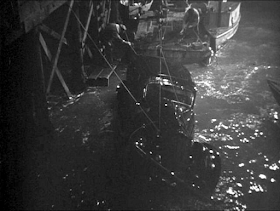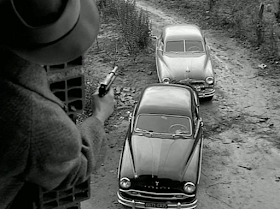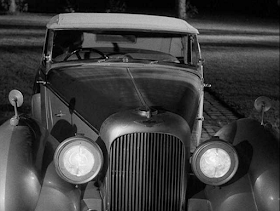It's night on a highway somewhere. In the opening sequence of "Kiss Me Deadly" we see a shadowy figure desperately trying to flag down a rapidly approaching car...
...which turns out to be a 1951 Jaguar XK120 roadster piloted by detective Mike Hammer. The lighting, the low angle of this shot, and even the shape of the car seem a reference to the brooding, ominous tone of 1940s film noir. But it's 1955, and our cynical protagonist always seems to be looking out for himself first as he tries to unravel a web of mystery and violence tied to an elusive black box, the Great Whatsit.
Director Robert Aldrich films inside the car to put us in the place of his characters, who are as uneasy with each other as we are uneasy with the looming darkness around them. Hammer is played by Ralph Meeker; Christina, the raincoat-clad fugitive, is played by Cloris Leachman in her first film role. We're somehow not surprised when thugs in a Cadillac attack Christina and push Hammer and his car off a cliff...
…though of course we wonder why. Hammer survives, while Christina, skeptical of Hammer's motives and values from the first moments of their brief time together, does not. Hammer gets another car, this time a Corvette, and the trail of destruction continues when thugs kill his mechanic by dropping a car onto him. The film ends on a beach with a nuclear blast as the Great Whatsit explodes, fulfilling its function as the hinge of a Cold War story of greed, cynicism and ruthlessness. As "The End" scrolls above the glowing, irradiated wreckage on the beach, we sense a climax to an era of stark, dark storytelling that began in another era of tension...
It's intriguing that while directors responded to the privations of the Great Depression by making screwball comedies like "It Happened One Night" and "Bringing Up Baby", the themes and mood of their work changed as clouds of another war settled over Europe. In England, Alfred Hitchcock was one of the first to signal the shift, with "Secret Agent" and "Sabotage" in 1936. In 1940, Hitchcock made his first Hollywood production, "Rebecca", not quite a film noir, but a suspenseful tale of secrets and deceptions, played out at a shadowy mansion. As he arrives in pouring rain in a 1937 MG SA with the top down, we sense things may not turn out well for our protagonist. Perhaps this scene reflected the frustration of dealing with the complexity of the MG's convertible top; the dim lighting seems to ask nothing of the car's Lucas headlights. The movie won an Oscar for Best Picture...
In 1941, John Huston directed Humphrey Bogart as detective Sam Spade in Dashiell Hammett's "The Maltese Falcon", and the lights on screen seemed to dim to match the world outside, while tense, slangy repartee replaced the snappy chatter of the Thirties comedies. The car in the scene below is a 1940 Buick Super.
Howard Hawks directed Bogart and Lauren Bacall in "The Big Sleep" in 1946, with Bogart playing Philip Marlowe. The plot intricacies may have been hard to navigate, but the sharp, cynical dialogue conveyed the mood as well as the cinematography, which was by Sidney Hickox. The fate of the Packard Super 8 below is a reminder of what can happen when the plot gets dark on a rainy night...
On film, images of American cities from this period seem influenced by painters like Edward Hopper (rather than the other way around), with rounded, streamlined forms of cars slipping down rain-slicked streets past dimly-lit cigar stores, and men in hats behind the wheel. Below, a Lincoln V12 in "A Street With No Name", from 1948...
The 1941 Lincoln Continental was another vehicle for Bogart, like the film in which it appears, "Dead Reckoning" from 1947. More rain at night, more dark streamlined shapes, and more plot twists than we might be able to follow on the first viewing.
In director Jules Dassin's immortal heist flick "Rififi", the car of choice for the jewel thieves is a Traction Avant Citroen 11. The significance may be that it was a car favored by gangsters as well as the gendarmerie, and by 1954, when filming began, the low-slung, front-wheel drive sedan designed over two decades earlier was as much a part of Parisian street scenes as, well, sidewalk cafés...
Dassin refused to film on sunny days, insisting on the gray tone that prevails, and he disagreed with composer Georges Auric, who wanted music in the stunning half-hour burglary scene filmed in real time; the result of using only ambient sound and dialog made this scene as tense as the getaway on slick Paris streets, filmed in the dim light of early morning.
The plot, like those streets, takes an unexpected turn with the kidnapping of a burglar's small son by rival hoods. The deftly composed scene below sets up a showdown at their hideout. The two cars are French Fords with flathead V8s, like the Citroen Traction, favorites of gangsters...but unlike the Citroen, not favorites of the police.
In a way, the French New Wave took over when and where American Film Noir left off. For stark depictions of human folly conveyed with economy and irony but delivered in English, Americans could turn on their TV sets for Rod Serling's "Twilight Zone" from 1959 to 1964. In "A Thing About Machines", the mean-spirited, mechanophobic central character, Bartlett Finchley, has to continually call upon repairmen to fix the machines he constantly abuses, in what seems in retrospect a precursor to today's "battered computer syndrome."
Finally his 1939 Lagonda LG6 has had enough. In a climax shot in dusky black and white, and oddly predictive of today's mishaps with self-driving cars, it starts up and shoves him into the pool, drowning him...
The scene below is another from "Dead Reckoning", in which Bogart and Lizabeth Scott escape after a shooting and fire at a nightclub. We'll leave you here on this lonesome, deserted highway to figure out the plot resolution for yourself. Make sure your headlights work, and your wipers too. And take your trench coat; you may need it...
Postscript:
There was also a vintage car that functioned as a critical plot device in a classic film noir, and, in a way, played a character. This was Gloria Swanson's 1929 Isotta Fraschini 8A in Billy Wilder's "Sunset Boulevard." This was enough of a landmark film event that we devoted the better part of a post to it back on September 4, 2016. It was part of the Forgotten Classic series, and subtitled "Sunset for a Dream"...
Post-Postscript:
Footnote:
This escapist fare is provided as a distraction for those wisely sheltering in place during the current pandemic. Organizations providing aid to those recently unemployed as a result of the pandemic-related business and institutional closures include the following:
Center for Disaster Philanthropy (disasterphilanthropy.org)
CDC Foundation. (cdcfoundation.org)
Feeding America. (feedingamerica.org)
Meals on Wheels. (mealsonwheelsamerica.org)
For international medical aid during the crisis, there's Médecins Sans Frontieres:
www.msf.org
For international medical aid during the crisis, there's Médecins Sans Frontieres:
www.msf.org
Photo credits:
Top: United Artists, posted on criterionconfessions.com
2nd thru 5th: United Artists, posted on imcdb.org (Internet Movie Car Database)
6th: Selznick International Pictures, posted on simanaitissays.files.wordpress.com
7th: imcdb.org
9th: i.pinimg.com
10th thru 14th: imcdb.org
15th: Columbia Pictures, from video posted on dailymotion.com
Bottom: Paramount Pictures (Isotta Fraschini in "Sunset Boulevard")

















Nice site, Mr. Poeschel. I think J.P. Belmondo/Michel in À bout de souffle deserves an entry here.
ReplyDeleteWe met in BAT, btw
ReplyDeleteGlad you enjoyed. You're right about Godard's "Breathless"; there's a 2 passenger T-Bird & and an Olds from the same era, and I think some kind of Facel-bodied Simca. It's been years since I've seen it, so I'm watching it tonight and will post pictures with yet another postscript. Thanks!
ReplyDeleteWhat type car was in Cry Wolf 1947?
ReplyDeleteWe cannot find "Cry Wolf" at our usual streaming sources, and failed to find it at imcdb.org, which is usually an excellent source for movie cars.
ReplyDeleteWe know a scene near the beginning involves a car driving next to a woman on horseback. We'll need to get back to you on this one...
I think it's a PACKARD ROLLSTON
DeleteWe'll try to find this on one of the other streaming services or at the Public Library. Errol Flynn had a Frazer Nash too, but that was long after 1947. A Packard Rollston would fit with the film's theme, and
ReplyDeletethe "asset class" of the participants, wouldn't it?
Yes, wealthy people have very nice cars, don't they?
ReplyDelete